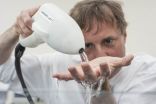Dominant strain of drug-resistant MRSA decreases in hospitals, but persists in community
2015-09-16
(Press-News.org) The incidence of the most common strain of Methicillin-resistant Staphylococcus aureus (MRSA) infections has decreased in hospital-onset cases, but has failed to decline in the broader community, according to new research published online today in Infection Control & Hospital Epidemiology, the journal of the Society for Healthcare Epidemiology of America.
The USA 300 strain of MRSA, has become prevalent in both communities and healthcare institutions. "In looking at risk factors for hospital or community-onset USA 300, current or former drug use was a strong predictor for acquiring this strain of bacteria," according to Kyle J. Popovich, MD, MS, the lead author of the study and Assistant Professor in the Section of Infectious Diseases, Rush University Medical Center, Chicago.
In the past 15 years, MRSA infections have evolved as the bacterium emerged as a significant pathogen in the community and hospitals in the U.S. Researchers studied 1,015 cases of Staphylococcus aureus bacterial bloodstream infections (BSI) over a six-year period at a Chicago "safety net" hospital. The study found that more than half of hospital-acquired cases were due to the USA 300 strain.
Recent national surveillance has suggested a decrease in the incidence of invasive hospital-acquired MRSA infections during the past decade, and researchers said their findings reaffirmed that observation in the Chicago region.
"Decreases in hospital-onset MRSA BSIs may be due to substantial efforts aimed to reduce healthcare-associated infection," said Popovich. "Enhanced prevention efforts in the community for certain populations, such as those engaging in illicit drug use, may be necessary to further curb the spread of invasive MRSA infections."
INFORMATION:
Yoona Rhee, Alla Aroutcheva, Bala Hota, Robert A. Weinstein, Kyle J. Popovich. "Evolving Epidemiology of Staphylococcus aureus Bacteremia." Web (September 16, 2015).
About ICHE
Published through a partnership between the Society for Healthcare Epidemiology of America and Cambridge University Press, Infection Control & Hospital Epidemiology provides original, peer-reviewed scientific articles for anyone involved with an infection control or epidemiology program in a hospital or healthcare facility. ICHE is ranked 13th out of 158 journals in its discipline in the latest Web of Knowledge Journal Citation Reports from Thomson Reuters.
SHEA is a professional society representing physicians and other healthcare professionals around the world with expertise and passion in healthcare epidemiology, infection prevention, and antimicrobial stewardship. SHEA's mission is to prevent and control healthcare-associated infections, improve the use of antibiotics in healthcare settings, and advance the field of healthcare epidemiology. SHEA improves patient care and healthcare worker safety in all healthcare settings through the critical contributions of healthcare epidemiology and improved antibiotic use. The society leads this specialty by promoting science and research, advocating for effective policies, providing high-quality education and training, and developing appropriate guidelines and guidance in practice. Visit SHEA online at http://www.shea-online.org, http://www.facebook.com/SHEApreventingHAIs and @SHEA_Epi.
About Cambridge Journals
Cambridge University Press publishes over 350 peer-reviewed academic journals across a wide spread of subject areas, in print and online. Many of these journals are leading academic publications in their fields and together form one of the most valuable and comprehensive bodies of research available today.
For further information about Cambridge Journals, visit journals.cambridge.org.
About Cambridge University Press
Cambridge University Press is part of the University of Cambridge. It furthers the University's mission by disseminating knowledge in the pursuit of education, learning and research at the highest international levels of excellence.
Its extensive peer-reviewed publishing lists comprise 45,000 titles covering academic research, professional development, over 350 research journals, school-level education, English language teaching and bible publishing.
Playing a leading role in today's international market place, Cambridge University Press has more than 50 offices around the globe, and it distributes its products to nearly every country in the world.
For further information about Cambridge University Press, visit cambridge.org.
ELSE PRESS RELEASES FROM THIS DATE:
2015-09-16
Amsterdam, September 16, 2015 - Targeted cancer treatments, toxicity sensors and living factories: synthetic biology has the potential to revolutionize science and medicine. But before the technology is ready for real-world applications, more attention needs to be paid to its safety and stability, say experts in a review article published in Current Opinion in Chemical Biology.
Synthetic biology involves engineering microbes like bacteria to program them to behave in certain ways. For example, bacteria can be engineered to glow when they detect certain molecules, and ...
2015-09-16
Washington -- A new analysis by the Synthetic Biology Project at the Wilson Center finds the Defense Department and its Defense Advanced Research Projects Agency (DARPA) funds much of the U.S. government's research in synthetic biology, with less than 1 percent of total federal funding going to risk research.
The report, U.S. Trends in Synthetic Biology Research, finds that between 2008 and 2014, the United States invested approximately $820 million dollars in synthetic biology research. In that time period, the Defense Department became a key funder of synthetic biology ...
2015-09-16
The first true three-dimensional picture of submarine canyon habitats has been produced using a unique combination of marine robotics and ship-based measurements. The information captured in this new set of maps ranges in scale from the 200km canyon down to the size of an individual cold-water coral polyp, and will be used to inform the management of the only English Marine Conservation Zone in deep water.
This 'nested map' is the result of a recent scientific expedition to the Whittard Canyon in the Bay of Biscay, led by the National Oceanography Centre (NOC). It works ...
2015-09-16
ROCHESTER, Minn. - Mayo Clinic researchers have identified a protein marker whose frequency may predict patient response to PD-1 blockade immunotherapy for melanoma. An abstract of their findings was presented today at the American Association for Cancer Research International Cancer Immunotherapy Conference in New York City.
"The discovery of biomarkers of sensitivity are vital not only for informing clinical decisions, but also to help identify which patients with melanoma, and possibly other malignancies, who are most likely to benefit from PD-1 blockade," says Roxana ...
2015-09-16
The oil and gas extraction method called hydraulic fracturing remains controversial for multiple reasons, one of which is its water use. But, as scientists report in ACS' journal Environmental Science & Technology Letters, water requirements for the process are potentially lower than those for some other energy-related extraction methods.
Since oil and gas companies ramped up hydraulic fracturing, or fracking, to unlock oil and gas from shale and tight oil formations, reports of earthquakes and contaminated water near wells proliferated. Some environmental experts have ...
2015-09-16
Detecting breast cancer in women with dense mammary tissues could become more reliable with a new mammogram procedure that researchers have now tested in pre-clinical studies of mice. In their report in the journal ACS Nano, they describe injecting gold nanoparticles in mammary tissue to enhance the imaging of early signs of breast cancer.
Mammography remains the clinical gold standard of screening tests for detecting breast cancer. However, a recognized limitation of this X-ray procedure is that dense breast tissue shows up as white masses and fibers on an image, ...
2015-09-16
Citizen science is taking off and could make a difference at regional and national regulatory levels. But not everyone thinks that's a good idea. The cover story of Chemical & Engineering News (C&EN), the weekly newsmagazine of the American Chemical Society, delves into the progress of the budding movement, as well as the pushback.
Steven K. Gibb, senior editor at C&EN, reports that in some states, regulators actively encourage and support local residents' participation in environmental monitoring. For example, Maryland's Department of the Environment and Department ...
2015-09-16
Fossils tell amazing stories and inspire them, too -- just think of this summer's "Jurassic World" blockbuster. But because some of the processes that preserve fossils are not well understood, there's still more information that they could reveal. Now scientists report in ACS' journal Analytical Chemistry a new way to probe fossils to find out how these ancient remains formed in greater detail than before.
When most organisms die, they biodegrade and leave little behind. But if they get trapped in sediments that harbor few bacteria and loads of dissolved minerals, they ...
2015-09-16
Coughing. A sore throat. Maybe a pain in your chest as you take a deep breath.
These are all common symptoms for many city-living Australians when smog levels are high. And while it is well understood that smog can cause such problems, new research has for the first time given us a glimpse as to what might be happening at the molecular level.
The University of Melbourne's Professor Richard O'Hair, from the School of Chemistry's Bio21 Institute, in collaboration with Professor Stephen Blanksby (from the Queensland University of Technology and formerly the University ...
2015-09-16
Researchers from the University of Southampton have demonstrated how a pioneering ultrasonic device can significantly improve the cleaning of medical instruments and reduce contamination and risk of infection.
StarStream, invented and patented by the University of Southampton and in commercial production by Ultrawave Ltd., makes water more efficient for cleaning by creating tiny bubbles which automatically scrub surfaces. The device supplies a gentle stream of water through a nozzle that generates ultrasound and bubbles, which dramatically improve the cleaning power of ...
LAST 30 PRESS RELEASES:
[Press-News.org] Dominant strain of drug-resistant MRSA decreases in hospitals, but persists in community

